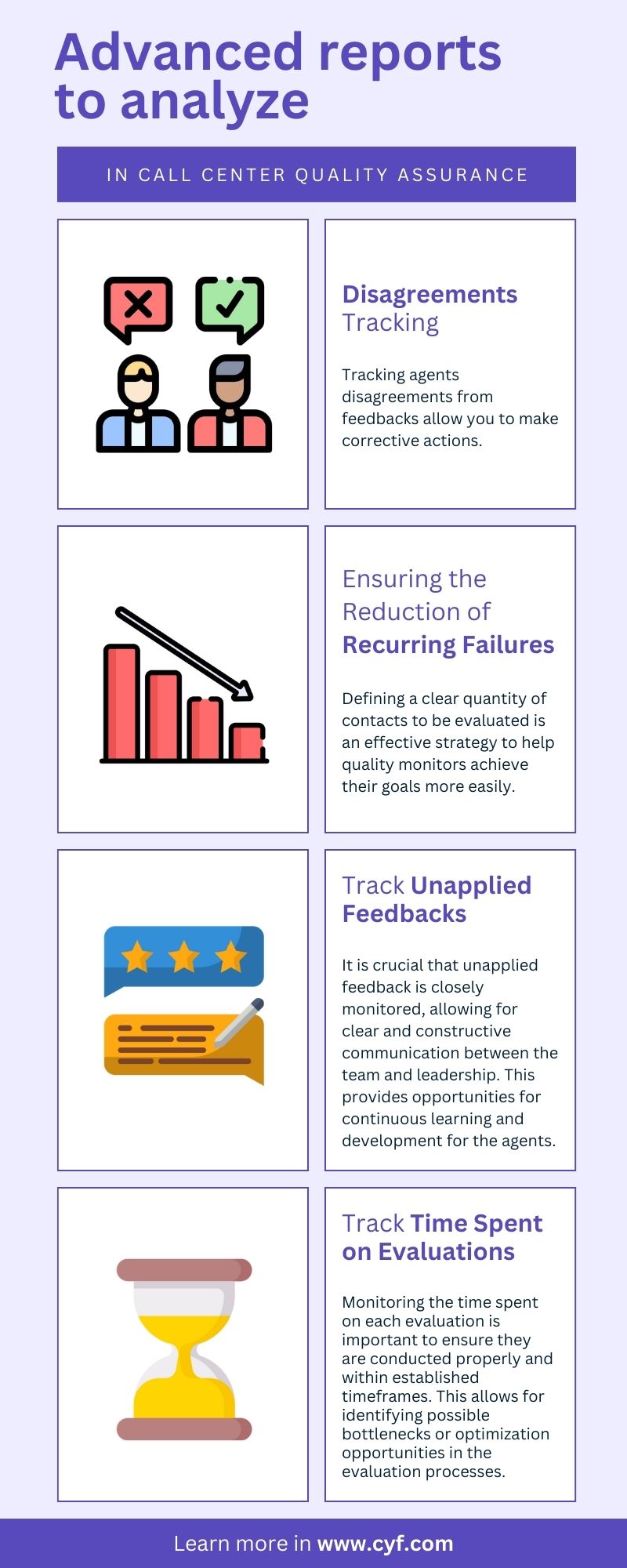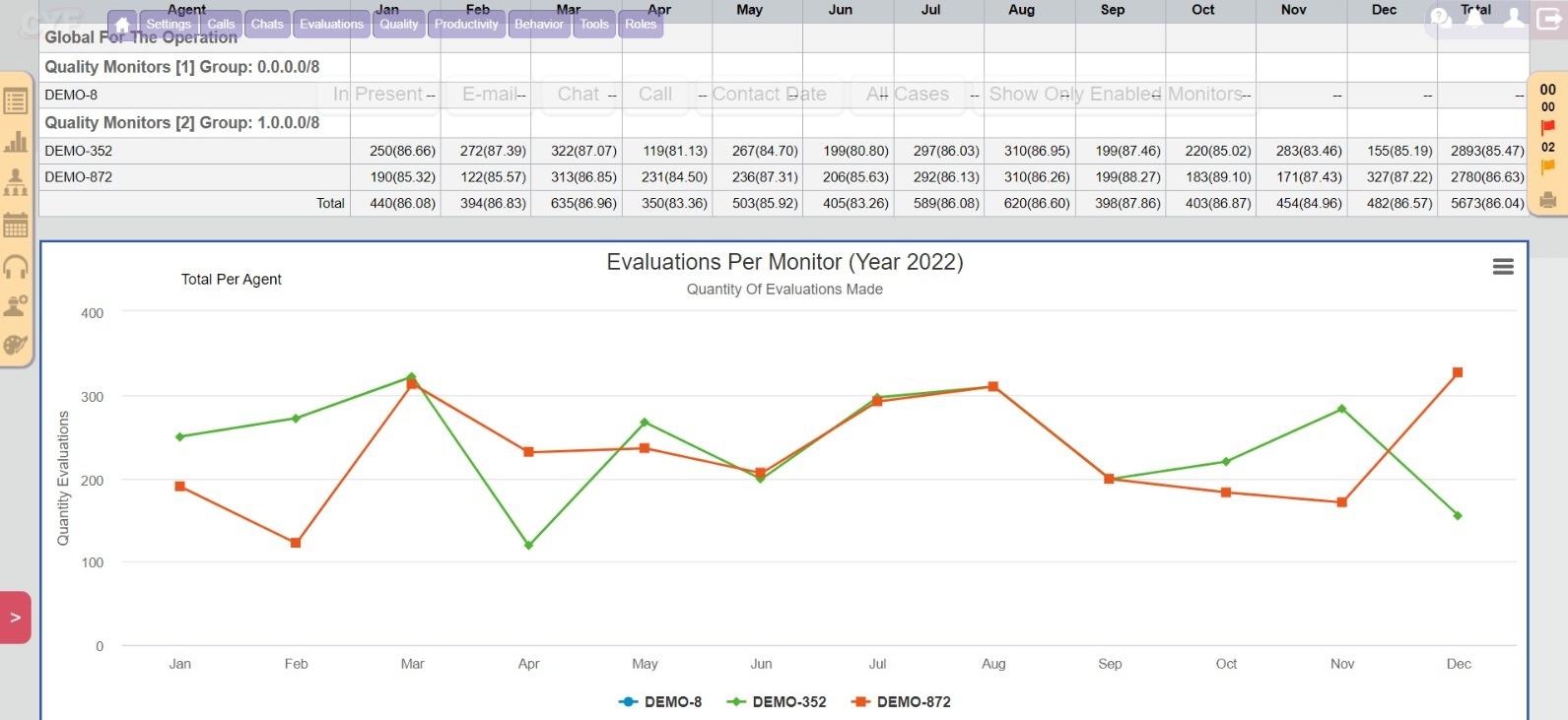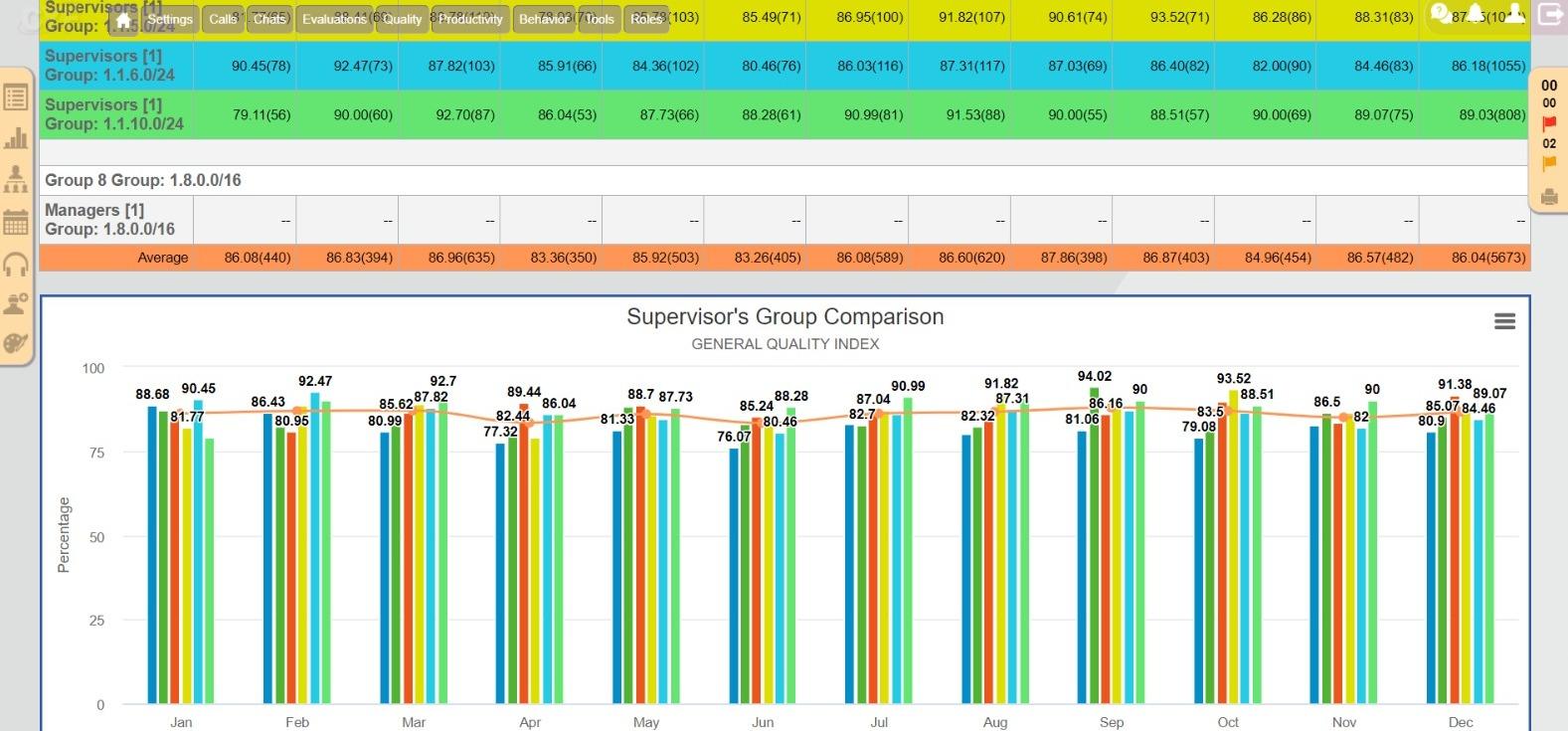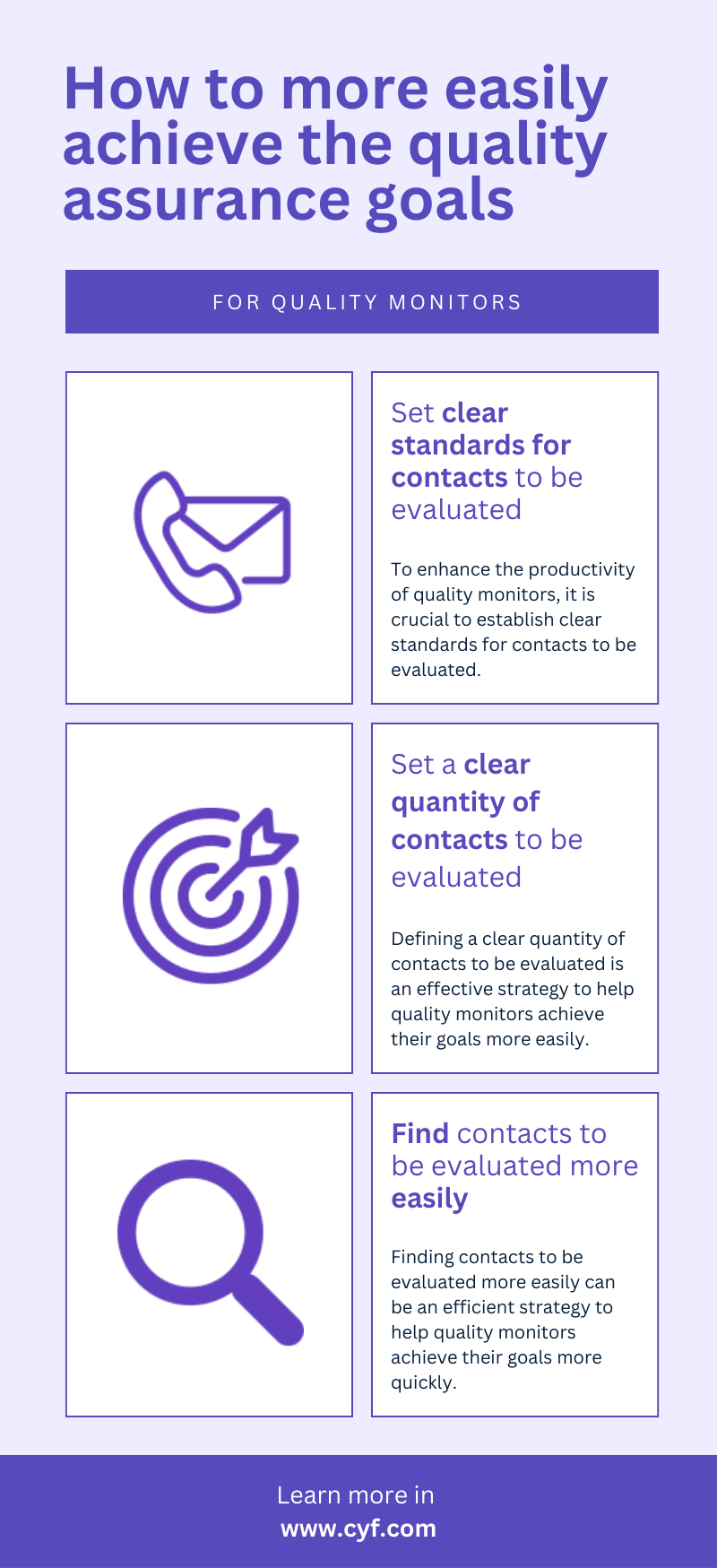Call Center Quality assurance plays a vital role in ensuring excellent customer service and high call center performance. To increase the productivity of quality monitors and streamline the assurance process, it is crucial to implement the most effective practices in the market. In this article, we will explore 15 Call Center Quality Assurance Best Practices to boost monitor productivity, gain better insights from results, and further enhance customer satisfaction.
How to more easily achieve the quality assurance goals for quality monitors?
To achieve a higher level of productivity, it is necessary to implement effective strategies. Defining these standards will enable quality monitors to optimize their evaluations and provide valuable feedback to enhance team performance, promoting greater productivity and satisfaction for both employees and customers. However, besides establishing clear standards, there are other strategies that can be adopted to further boost the productivity of quality monitors.
1. Establish Clear Criteria for Assessment
Setting well-defined standards is the first step to optimizing productivity.
1. Priority contacts:
– Sales, customer retention or solving recurring problems.
-Interactions with low satisfaction scores (CSAT) to identify gaps in service.
2. AHT (Average Handle Time) criteria:
– Contacts with specific or non-standard (too long or short).
3. Expected results:
-Identify opportunities for improvement and provide targeted feedback to enhance performance.
2. Define a clear number of contacts to be evaluated:
Defining a clear number of contacts to evaluate is an effective strategy to help quality monitors achieve their goals more easily. We will cover the following topics related to this strategy:
1. Reasons for contact:
– Sales: evaluate 100% of sales to analyze the performance of agents in this aspect.
– Non-sales: include a sample to evaluate how agents deal with situations in which there is no conversion into sales.
2. CSAT (Customer Satisfaction Score):
– Evaluate a representative sample of contacts to measure the level of customer satisfaction and obtain insights into the quality of service.
3. Complaints:
– Analyze a sample of complaint-related contacts to identify problem areas and provide targeted feedback.
4. Service channels:
– Include different channels, such as chatbot, telephone and email, in the number of contacts evaluated.
– Evaluate the efficiency of the chatbot, the accuracy of responses and the ability to direct the customer to a human agent when necessary.
Defining a clear number of contacts to be evaluated considering these topics provides a comprehensive view of agents’ performance and enables significant improvements in customer service.
3. How to find contacts to evaluate more easily:
Finding contacts to evaluate more easily can be an efficient strategy to help quality monitors achieve their goals more quickly. Here are some relevant topics to consider in this process:
1. Search for contacts:
– Use advanced filters in the contact management system to segment and identify specific groups of interactions.
– Explore criteria such as date, time, type of channel (phone, chat, email, etc.) and reason for contact to refine the search.
– Consider using relevant keywords related to the main topics to be evaluated.
2. TMA (Average Service Time):
– Prioritize the evaluation of contacts with longer TMA, as they may contain more complex interactions or require more time to handle.
– Identify trends in contacts with high TMA to identify opportunities for improvement and specific training.
3. Tagging in the system:
– Implement an efficient tagging system to categorize contacts according to relevant topics.
– Define specific tags that are useful for identifying areas for improvement and training opportunities.
– Perform a periodic analysis of the most common tags to identify patterns and act proactively.
4. Targeting in the URA (Audible Response Unit):
– Evaluate the contacts that passed through the URA to identify possible problems with routing or customer experience.
– Monitor options selected by customers during IVR targeting to identify call patterns and potential areas for improvement.
5. Contact content (AI and Speech Analytics):
– Use AI and speech analysis technologies to extract valuable insights from contact content.
– Identify recurring keywords, expressions or problems in customer interactions to prioritize the evaluation of these contacts.
– Analyze customer sentiment during the interaction to identify opportunities to improve the quality of service.
By adopting these strategies for searching for contacts, tagging in the system, targeting in the URA and analyzing the content of contacts, quality monitors will be able to optimize their work and achieve their goals more efficiently, in addition to identifying areas for improvement in customer service. .2. Integrate your quality system:
Integrating your quality system with other call center tools and technologies is essential to increase productivity.
Integration brings several benefits, such as:
- Continuous data feed.
- Reduced manual effort for searches mentioned above.
- Guarantee of accurate and real-time information.
Connecting your quality system with your CRM software, customer service systems and other relevant platforms will allow monitors to access all necessary information within a single system, greatly increasing the team’s day-to-day efficiency.
4. Integrate the Quality System
Connecting tools and systems is essential to reduce manual work and improve data accuracy.
- Benefits of integration:
- Continuous data feed.
- Reduction of manual effort in searching for information.
- Accurate and real-time information.
- Recommended tools:
- Connect the quality system to CRM, service platforms and other relevant software to centralize data and speed up work.
5. Provide personal feedback only when necessary:
“Face-to-face” feedback sessions with agents can be time-consuming and not always necessary. Prioritize the use of electronic feedback within your monitoring system or at most other systems such as video conferencing. These methods allow monitors to provide feedback remotely, saving money time and resources.
Reserve in-person feedback sessions for critical situations that require immediate attention or when a personal touch is essential to agent development.
By implementing these strategies, quality monitors can optimize their work, achieve goals more easily, and promote high-quality service. With clear criteria, well-defined processes and integration of tools, the positive impact will be felt by the entire team and customers.
Using Artificial Intelligence to further facilitate the work of call center quality assurance.
6. Transcribe audios:
Transcribing call recordings offers several benefits in terms of quality productivity. Audio-to-text conversion allows displays to:
- Greater agility in reading than listening to a call.
- Search for specific keywords or phrases in conversations, saving valuable time.
In some transcription engines you may miss:
- Error rate, especially on poor quality calls
- Quiet time
- voice tom
Transcriptions can be performed manually or automated using speech-to-text technologies, further optimizing the quality process.
No CYF Quality AI, the monitors will have the transcriptions automatically and alongside the evaluation form, further improving productivity.
Additionally, we include quiet times and customer sentiment to overcome the problems mentioned above.
7. AI Conversations Summary (CYF Copilot)
CYF Copilot is an innovative feature of CYF Quality that optimizes the monitoring process by automatically generating detailed descriptions of services. Using advanced natural language analysis technology, the system identifies and organizes essential information, eliminating the need to listen to or read entire contacts.
The tool integrates directly with the monitoring form, making the assessment faster, clearer and more efficient, without compromising data security.
Main points:
✅ Intelligent Automation: Generates accurate service summaries without the need for manual analysis.
✅ Ease of Use: Simply attach the contact and follow the description generated on the monitoring screen.
✅ Guaranteed Security: All processing takes place on CYF servers, without sharing data with third parties.
✅ Benefits: Increased efficiency, clarity of information and greater accuracy in evaluation.
CYF Copilot transforms monitoring, providing more quality and agility in the process. 🚀
8. Automate Your Evaluations with AI
AI can also transform the way assessments are carried out. Intelligent systems can be trained to:
- Evaluate calls based on predefined criteria.
- Replicate the watchful eye of experienced monitors.
No CYF Quality AI, the automatic assessment process is centralized and efficient, offering:
- Immediate electronic feedback.
- Dispute and audit tools.
- Freeing up time for monitors to focus on more complex tasks.
Tip: Always maintain a balance, ensuring human intervention in cases that require more sensitive judgment.
How to better analyze the reported data?

Analyzing the data from quality assurance reports effectively is crucial to identify trends, make informed decisions, evaluate the effectiveness of corrective actions, identify training needs, monitor progress over time, and gain valuable insights from customers. This improves the overall quality and performance of the organization. Therefore, let’s go through the best practices:
7.
Dispute tracking:
Closely monitoring complaints made by attendants is essential to identify patterns and trends… This thorough monitoring allows targeted corrective actions to be implemented, such as specific training for attendants or updates to operational procedures within the monitoring team.
Here are some examples of points to keep an eye on:
- Items with the highest number of disputes
- Attendants who object most
- Monitors that receive the most complaints
8.
10. Reducing Recurrence of Most Failed Items
Recurrent items compromise the quality of the service. To minimize its recurrence:
- Use offender reports to identify the most frequent points of failure.
- Offer constructive feedback and targeted training, strengthening the skills of attendants.
- Implement preventative measures, such as best practice manuals and standardized processes.
✨ Result: Less recurrence of failures, greater customer satisfaction and excellent service.
9. Monitoring unapplied feedback:
Monitoring feedback not applied to agents in quality monitoring is extremely important due to the following topics:
- Stagnant performance: A lack of feedback can prevent agents from realizing areas where they need to improve, resulting in stagnant performance and a lack of professional growth.
- Repetition of errors: The lack of monitoring of unapplied feedback can lead to recurring errors and the repetition of inappropriate behaviors, damaging the quality of service and customer satisfaction.
- Lack of motivation among agents: The lack of a structured process for reviewing and addressing unapplied feedback can create an environment of demotivation among agents. They may feel neglected and unappreciated, which negatively impacts their engagement and performance at work.
Therefore, it is crucial that unapplied feedback is closely monitored, allowing for clear and constructive communication between the team and leadership. This provides continuous learning and development opportunities for agents.
10. Monitoring the Productivity of Quality Monitors
Ensuring the productivity of quality monitors is essential for the success of the evaluation process. Focus on the following points:
- Setting clear goals: Establish an ideal number of assessments per period.
- Quality of assessments: Ensure assessment criteria are rigorous and consistent.
- Duration of assessments: Monitor the time spent on each analysis to identify bottlenecks.
- Idle time management: Evaluate and optimize task allocation to maximize efficiency.
📈 Recommended improvements:
- Offer specific training to monitors to improve their skills.
- Adopt automation tools for repetitive tasks, improving data analysis and productivity.
- Evaluate the interaction between monitors and those evaluated, ensuring constructive feedback and positive engagement.
At CYF Quality you can…

Improve your customer experience even more.
Especially in today’s highly competitive environment, providing exceptional experiences to customers is fundamental, particularly for call centers. By implementing these best practices, we can further improve the customer experience, boosting customer satisfaction and loyalty. Here are the strategies to adapt to take your customer experience to the next level:
11. Compare CSAT to Quality Score
Combine metrics for a complete view
- CSAT (Customer Satisfaction Score): Directly measures customer satisfaction for specific events, such as a purchase or interaction.
- Quality Index: Evaluates service efficiency and compliance from an internal perspective, such as accuracy, problem resolution, and adherence to standards.
- Why compare?
- One High CSAT and low Quality Score may indicate a good momentary experience, but with structural flaws.
- One Low CSAT and high Quality Score suggests that while standards are being met, something about the overall experience needs to be adjusted.

Using these metrics together allows for deeper, more targeted analysis, helping to align expectations and improve quality sustainably.
12. Analyze Customer Sentiment:
Analyze customer sentiment:
Analyzing customer sentiment in a call center can be extremely beneficial in improving the overall customer experience. Here are some ways to perform this analysis and leverage the insights gained:
- Monitoring interactions: Record and monitor call center calls to capture the tone of voice, keywords and expressions used by customers. This will help identify signs of emotions, such as frustration, satisfaction, anxiety, among others.
- Sentiment analysis: Use sentiment analysis techniques, which involve natural language processing, to identify the emotional tone of conversations based on the words and expressions used by customers. Sentiment analysis algorithms can assign a positivity, negativity, or neutrality score to each interaction.
- Categorization of emotions: Classify the emotions identified in interactions into relevant categories, such as satisfaction, dissatisfaction, anger, joy, concern, among others. This categorization will allow you to understand the main feelings experienced by customers during interactions.
- Identifying patterns: Analyze data collected over time to identify patterns and trends in customer sentiment. For example, you may find that certain product issues often generate feelings of frustration. This analysis will allow you to take proactive measures to resolve recurring issues.
- Integration with feedback and evaluations: Associate sentiment analysis with customer satisfaction and feedback surveys. This will provide a more complete view of the customer experience and help identify specific areas that need improvement.
- Staff training and development: Use information about customer sentiment to provide appropriate training and guidance to call center staff. Understanding how interactions affect customers’ emotions will allow agents to adjust their approach to ensure more positive customer service.
- Personalization and adjustments in approach: Based on sentiment analysis, adapt the service approach to meet customers’ emotional needs. For example, if a customer is showing frustration, it is important that the agent adopts an empathetic stance and offers quick and efficient solutions.
By analyzing customer sentiment in a call center, you will gain a deeper understanding of their emotional needs and expectations. This will allow you to take steps to enhance the customer experience, identify opportunities for improvement, and increase overall satisfaction.
13. Evaluate All Customer Service Channels:
Evaluating all customer service channels in quality assurance can enhance the customer experience for several reasons:
1. Identify Areas for Improvement: Assessing all customer service channels, such as phone, chat, email, social media, among others, helps identify areas where performance can be improved. This includes identifying recurring issues, communication bottlenecks, and gaps in customer service.
2. Provide Consistency: Evaluating all customer service channels ensures that the customer experience is consistent across all interactions. Each channel has its peculiarities and specific challenges, and assurance all of them helps ensure that quality standards are maintained at all touchpoints.
3. Adapt to Customer Preferences: Each customer may have different preferences in terms of service channels. Some may prefer to talk over the phone, while others may opt for online interactions. By evaluating all channels, you can identify customer preferences and adapt the service strategy accordingly, offering a personalized experience.
4. Identify Trends and Patterns: By assurance all customer service channels, you can identify trends and patterns in customer interactions. For example, you may notice that certain questions or issues are frequent on a particular channel, allowing you to take proactive measures to resolve these recurring matters and improve the overall experience.
5. Optimize Resources: Evaluating all customer service channels enables the optimization of available resources. For instance, if it’s found that a specific channel is receiving less demand than others, resources can be reallocated to ensure better service in the more frequently used channels. This helps maximize efficiency and customer service quality.
Overall, evaluating all customer service channels in quality assurance allows for a comprehensive understanding of the customer experience, identifying areas for improvement, ensuring consistency, adapting to customer preferences, identifying trends, and optimizing resources. This results in a more satisfying customer experience, which can lead to increased customer loyalty and business growth.
14. Reward Customers for Providing Feedback:
Rewarding customers who leave quality feedback can significantly enhance the customer experience for various reasons. Here are some key reasons:
1. Feedback Incentive: By rewarding customers for providing valuable feedback about their products or services, companies encourage them to share their opinions and experiences, fostering a culture of sharing and continuous improvement.
2. Customer Recognition: By rewarding customers who leave quality feedback, companies show appreciation and recognition for the time and effort invested in providing helpful feedback. This strengthens the relationship between the company and the customer, creating a sense of value and loyalty.
3. Quality Improvement: Customer feedback is a valuable source of information to identify areas for improvement in products or services. By rewarding those who leave quality feedback, companies incentivize active customer participation in identifying and solving issues, contributing to continuous quality improvement.
4. Positive Word-of-Mouth: Satisfied customers who are rewarded for leaving quality feedback are more likely to share their positive experiences with others. This can lead to increased word-of-mouth promotion and enhance the company’s reputation, attracting new customers.
Here are some successful examples of programs that reward customers for quality feedback:
1. Starbucks: Starbucks has a program called “My Starbucks Idea,” which encourages customers to share their ideas to improve the in-store experience. Customers can submit suggestions online and receive rewards, such as gift cards, when their ideas are implemented.
2. TripAdvisor: TripAdvisor is an online platform for hotel, restaurant, and attraction reviews. Users who contribute quality reviews and helpful information are recognized with “Top Contributor” status and receive special badges on their profiles, increasing their visibility and reputation within the community.
3. Amazon: Amazon encourages customers to leave detailed and helpful reviews about the products they purchased. Those who write high-quality reviews that are deemed helpful by other users may receive benefits, such as discounts on future purchases.
These are just a few examples of how rewarding customers for quality feedback can improve the customer experience and drive business growth. These strategies incentivize active customer participation, promote loyalty, and provide valuable insights for continuous improvement.
15. Evaluate 100% of Customer Interactions:
Evaluating the quality of 100% of call center interactions can significantly improve the customer experience for several reasons:
1. Identification of Recurring Issues: Assessing all interactions allows the identification of problems or difficulties that occur frequently. This helps identify patterns and areas for improvement in customer service, enabling the company to implement proactive solutions to prevent these issues from occurring in the future.
2. Standardization of Service: Evaluating all interactions helps establish clear standards and guidelines for customer service. This ensures that all call center agents are following best practices and providing consistent service. Standardization contributes to a more uniform and reliable experience for customers.
3. Identification of Training Needs: By evaluating all interactions, it’s possible to identify knowledge or skill gaps in call center agents. These assessments provide valuable insights into areas where agents may need additional training. By offering proper training, agents will be better equipped to handle a wide range of situations and meet customer needs more effectively.
4. Customer Satisfaction Assurance: Evaluating all interactions allows for more accurate measurement of customer satisfaction. The evaluations can include specific questions related to the customer experience, enabling the company to identify areas where customer satisfaction may be below expectations. With these insights, the company can implement targeted improvements to ensure the customer experience is satisfactory in all interactions.
5. Continuous Improvement: By evaluating 100% of interactions, the company can adopt a continuous improvement approach. With constant feedback and analysis, it’s possible to identify opportunities for enhancement and implement progressive changes. This results in a more efficient call center capable of providing high-quality service to customers.
Overall, evaluating the quality of 100% of call center interactions allows the company to identify issues, implement improvements, train agents adequately, and provide a consistent and satisfactory experience to customers. This approach helps strengthen the company’s reputation, increase customer loyalty, and promote a positive relationship with the public.
Conclusion:
The implementation of effective best practices for call center quality is essential to increase customer satisfaction. By comparing metrics such as CSAT and Quality Index, call centers can gain valuable insights into their performance and make informed decisions. Setting clear quality standards, conducting regular call assurance and evaluation, investing in agent training and development, creating a feedback loop for continuous improvement, and recognizing exceptional performance through incentives are crucial steps. By prioritizing these recommended practices, call centers can enhance their quality processes, provide exceptional customer service, and ultimately achieve higher levels of customer satisfaction.

